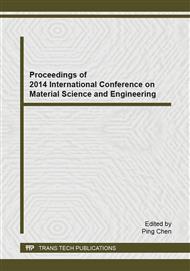p.23
p.27
p.36
p.41
p.45
p.53
p.58
p.62
p.67
Study on the Impact of Degummed on Pineapple Leaf Fiber’s Structures and Formaldehyde Adsorptions
Abstract:
The micro-structural and formaldehyde adsorption abilities of pineapple leaf raw and degummed fibers are characterized by using SEM, FT-IR, chemical composition analysis and determination of acidic oxygen-containing functional groups and more other methods. Test results show that after being degummed, pineapple leaf fibers possess smoother surfaces, obvious grooves, better single-fiber separations and non-significant cross-sectional cavities. Hemicellulose’s characteristic absorption peaks disappear basically and their contents are reduced from 20.62% to 2.65%. The intensities of lignins’ characteristic absorption peaks drop and their contents are decreased from 3.68% to 1.20%. The locations of celluloses’ characteristic absorption peaks do not change too significantly and their contents are increased from 61.18% to 84.45%. The numbers of carboxyl, lactone and phenolic hydroxyl in acid oxygen-containing functional groups are reduced. Pineapple leaf raw fibers have higher formaldehyde adsorption abilities. After degumming, formaldehyde adsorption abilities of pineapple leaf fibers are similar, but all slightly lower than raw fibers.
Info:
Periodical:
Pages:
45-52
Citation:
Online since:
October 2014
Authors:
Keywords:
Price:
Сopyright:
© 2014 Trans Tech Publications Ltd. All Rights Reserved
Share:
Citation:


